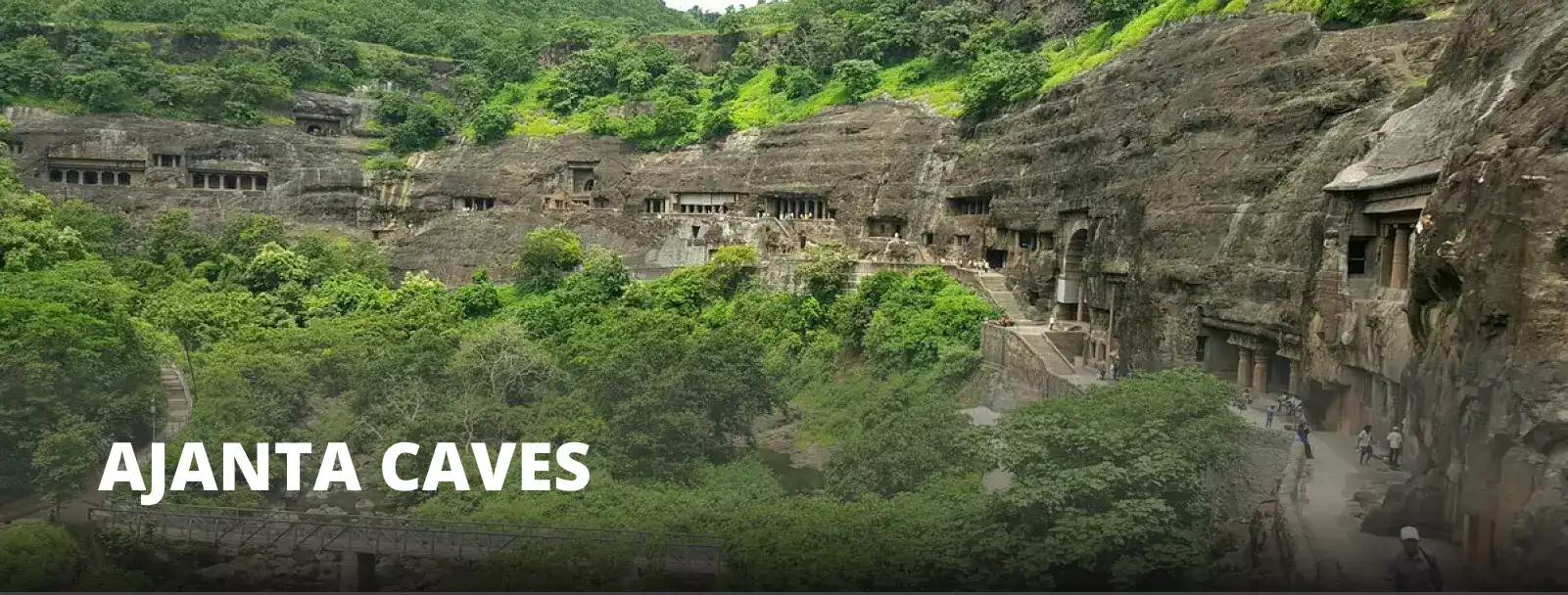
Location: Aurangabad, Maharashtra
Built by: Buddhist monks
Built in the Year: In the 1st century CE to 2nd century BCE
Timings: 9 am to 5 pm
Entry Fee: Rs40 for Indians, Rs600 for foreign nationals, and free for children below 15 years
Nestled in the hills of Northwest India away from the bustling modern life, lies a magnificent jewel of art and architecture – the Ajanta Caves. Located in Aurangabad, Maharashtra, Ajanta Caves are a UNESCO World Heritage Site and a world-renowned rock-cut caves visited by numerous travelers from across the globe. Consisting of 30 caves and devoted to the life of Buddha, each cave in Ajanta has sculptures, murals, and ceiling paintings that were built hundreds of centuries ago.
Ajanta Caves were sanctuary for the Buddhist monks that were forgotten for nearly 1500 years and were later discovered accidently in 1819. Unknown for over a millennium, except to wild animals, insects, flood waters, dense foliage, and probably to local Bhil people, this magnificent architecture was abandoned by those who created it long ago in 500 AD.
Renowned for the 30 odd rock-cut caves and their early Buddhist temple architecture with delicately drawn murals, the Ajanta Caves are huddled at a 76-meter height, horseshoe-shaped escarpment overlooking the Waghora (Tiger) River. Although there are 30 caves, these were cut out in two phases that provided shelter to the Buddhist Monks who came here to meditate during the monsoon. The ancient and original name of the heritage site is unknown, and the current name is derived from a neighboring village, whose local pronunciation is ‘Ajintha’. The caves have masterpiece paintings of Buddhist religious art that profess the stories about the previous lives of Buddha and our ancestors.
Ajanta Caves date back to as old as 1st century CE and 2nd century BCE and were carved out of a 250 ft. wall featuring monasteries and Buddhist halls of worship. The caves were hidden until the 17th century when a British officer unintentionally discovered these while on a trek. The excavation activity was carried out in two separate phases broken by a period of four centuries. The first phase overlaps with the regime of Satavahana dynasty from about the 2nd century BCE to 1st century BCE, while the second phase parallels to the Basim branch of the Vakataka dynasty with their Asmaka and Rishikaliegemen in the 5th to 6th centuries CE. Six caves (caves 8, 9, 10, 12, 13, and 15A) were excavated during the first phase of Hinayana followers of Buddhism and in the second phase the rupestrian activity was dominated by the Mahayana followers of Buddhism, where Buddha was revered in an idol form.
The caves consist of 36 identifiable foundations, some of them discovered after the original numbering of the caves from 1 through 29.The caves those were later identified were suffixed with the letters of the alphabet, such as 15A, which have been identified between the originally numbered caves 15 and 16. The numbering in the caves is only a convention of convenience and does not reflect the sequential order of their construction. The murals in these caves describe stories from the Jatakas and the later caves depict the artistic influence of the Gupta period, but there have been no specific dates as to which century the early caves were built.

Ajanta Caves are rock-cut caves built from the Basalt accumulated in the form of igneous rocks that have been amassed due to the volcanic eruptions occurred long back. The workers carved these rocks with utmost planning and detail and carved out pillars, roofs, and idols of these rock formations. Along with the idols of deities, exquisite wall paintings have also been carved out from the stone. The entry gate for the caves is through a gateway built between cave 15 and 16 and is decorated with elephant and caves.
Monasteries: Mostly the caves are in the form of Viharas that have dormitories connected to them while at the back side of the caves, a sanctuary has been built with a statue of Lord Buddha in each of the sanctuary. Several deities are also engraved on the pillars and near the enormous statue of Buddha. These caves have been built during the second phase and were shifted from Hinayana sect to Mahayana sect. The said features of these caves made them to be known as monasteries. The center of the viharas is in the form of a square having rectangular aisles at each side and several small cells are there which can be entered through the doors made up of wood.
Worship Halls The worship halls, also called as Chaitya Grihas, was built in the form of a rectangle. The halls are divided into two aisles and consists of a stupa (a hemispherical structure having the remains of Buddhist monks and nuns) and an aspe (a semi-circular structure having a vault or semi-dome). Circumambulation around the stupa was performed which is surrounded by pillars. Some caves have very huge entrances having windows which were the source of direct sunlight. Though the composition of the worship halls portrayed the architecture of Christian Church, but they didn’t have any chapel.
Ajanta Caves displays a set of 30 rock-cut caves defining some of the finest paintigs and sculptures ever recorded in human history. While the entire site is a sight to behold, do not miss out on Cave 1, 2, 4 and 17.
Timings – 9am to 9:30pm (Monday closed)
Entry Fees – INR40/person (Indians), INR600/person (Foreigners)
INR25 per camera and free for children below 15 years
By Air: The nearest airport is Aurangabad airport which is 100km away and is connected to major cities. You can get a bus or cab from near the airport to directly te caves.
By Train: The nearest railway station from Ajanta Ellora Caves is the Jalgaon Railway Station at 60km away.
By Road: Aurangabad is easily ace via road from distinct neighboring cities and state-run buses are easily available from all cities in Maharashtra .

Witness the grandeur and magnificence of the rock-cut Ajanta Caves located in Aurangabad, Maharashtra, and enveloped by a panoramic view of lush green mountains. The Ajanta Caves are dedicated to Lord Buddha and comprise 29 caves with several paintings, sculptures, and other structures depicting the past lives and rebirth of Gautam Buddha.
Ajanta caves are in Aurangabad district in Maharashtra.
Ajanta Caves have been built over several centuries by distinct dynasties such as Satavahana dynasty, the Mauryan Empire, Rashtrakuta dynasty, and Yadava dynasty.
Ajanta Caves were discovered by a British officer during the 17th century while on his trek as they were covered under the thick greenery.
Ajanta caves are much closer to each other and are renowned for their paintings and dedicated to Buddhism. While Ellora Caves are comparatively dispersed and known for their mythological sculptures and devoted to Buddhism, Hinduism, and Jainism.
Copyright 2012-2022 Indiamap Digital Pvt Ltd. All rights reserved. Privacy Policy | Terms of Use